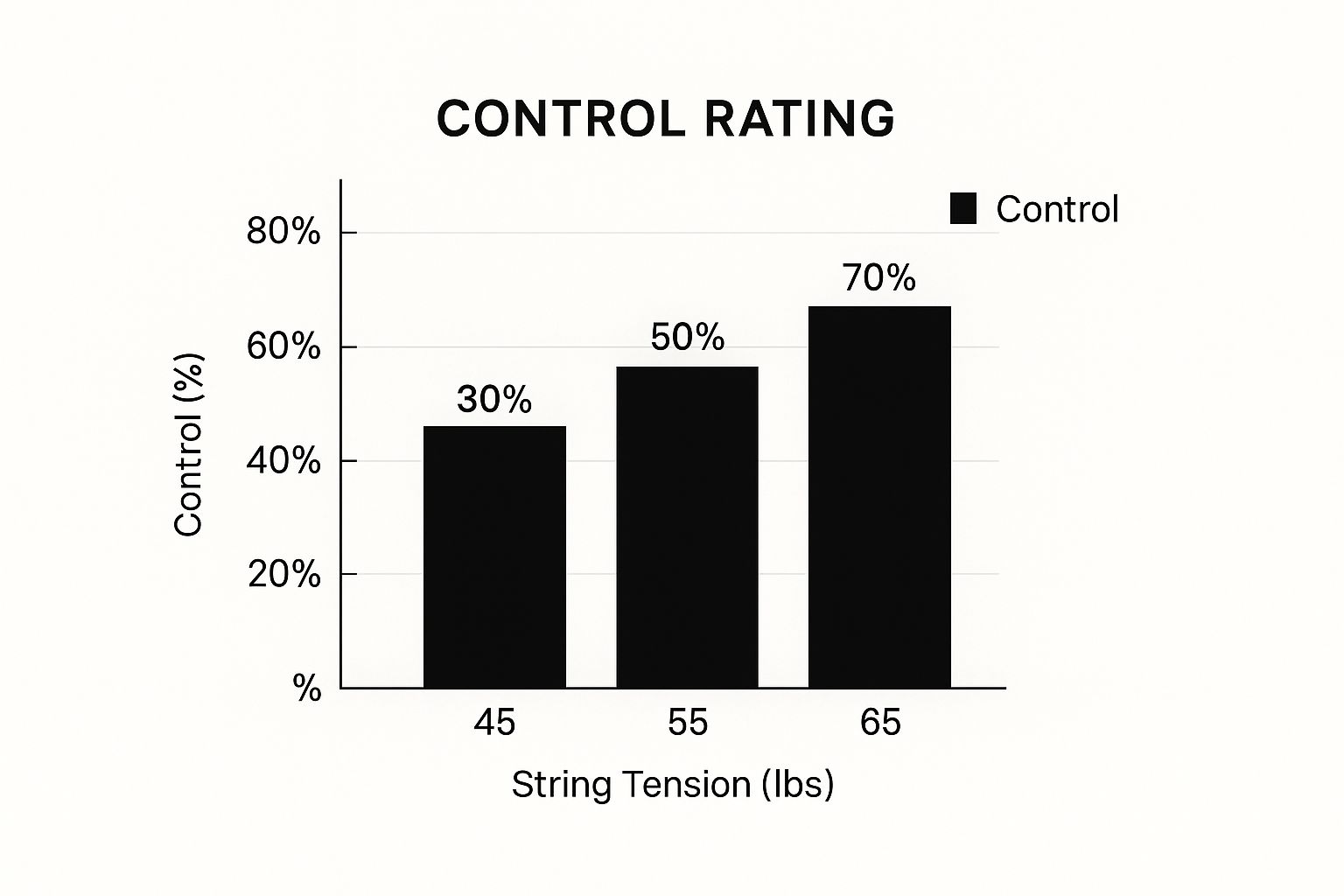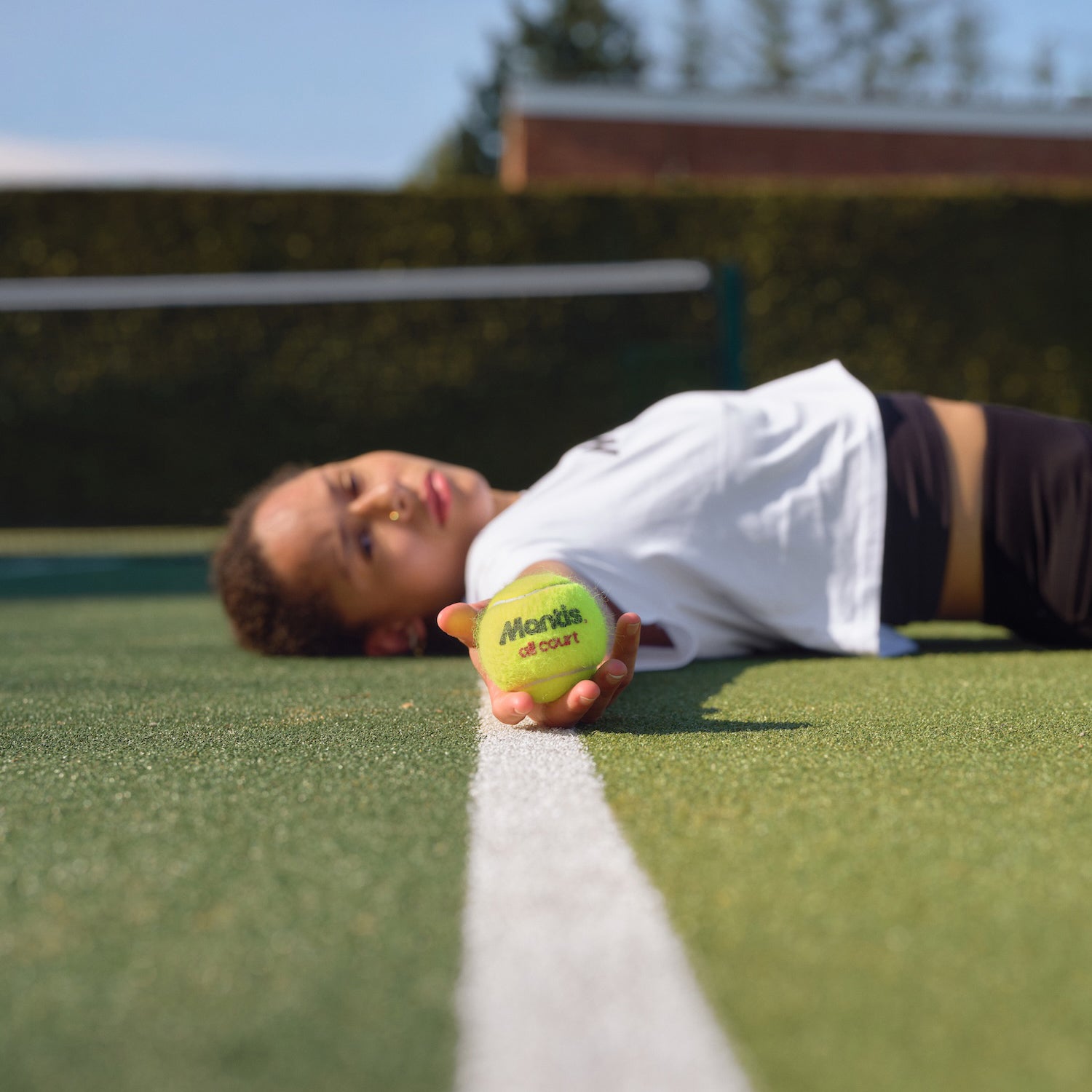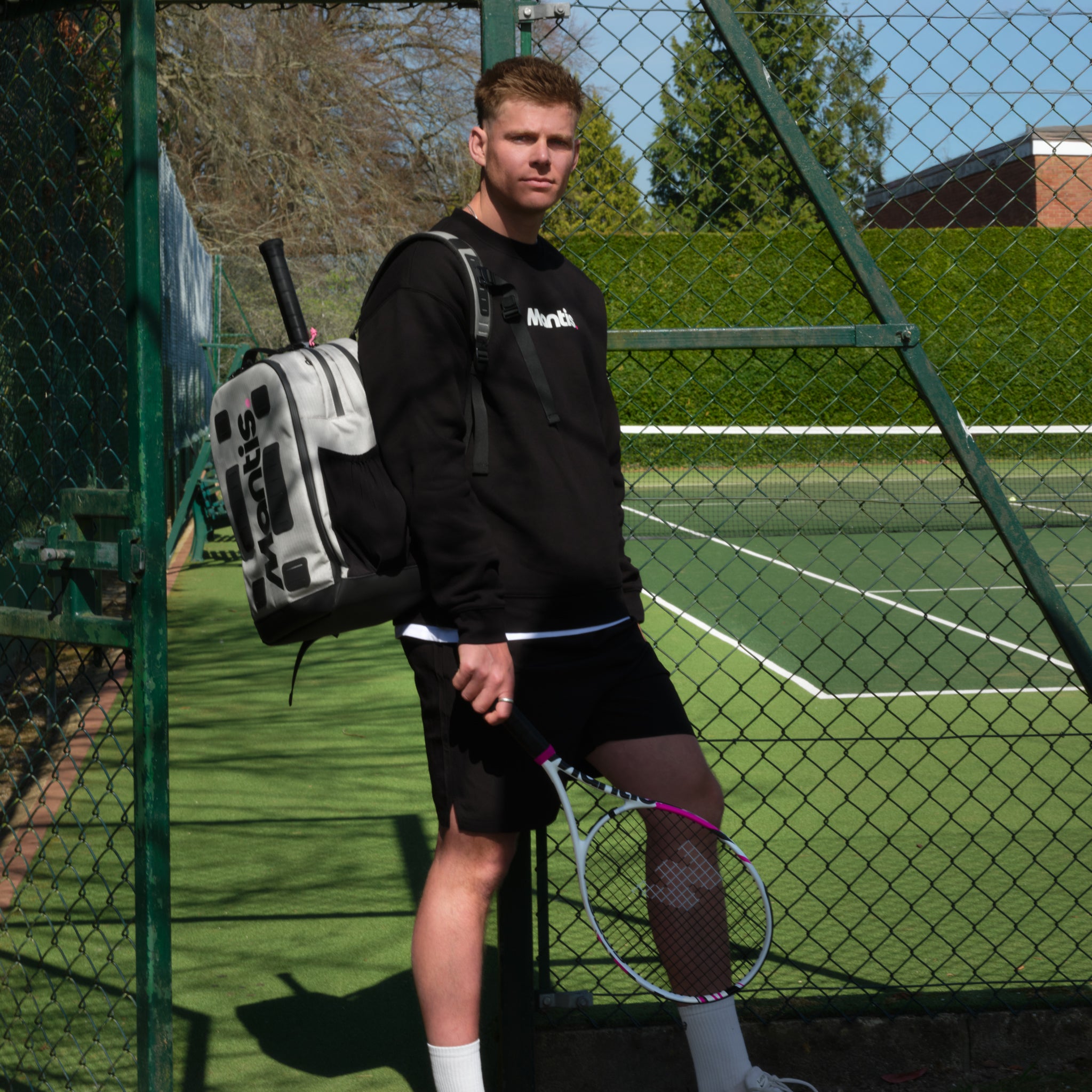
String tension is the force used to pull the strings taut across your racquet’s frame, usually measured in pounds (lbs) or kilograms (kgs). Here at Mantis, we know this single number is one of the most critical factors you can tweak, dictating the all-important balance between power and control. As we cover in our guide to tennis racquet strings, getting this balance right is fundamental to taking your game to the next level.
Unpacking The Concept Of String Tension
Think of string tension like tuning a guitar. A musician tightens or loosens the strings to hit the perfect note; a tennis player does the same to dial in the perfect feel and response from the string bed. It’s this adjustment that completely changes how the racquet and ball interact at that crucial moment of impact.
The best way to get your head around this is with a simple analogy we often use with players: a trampoline.
The Trampoline Effect Explained
Imagine you have two trampolines side by side. One has a very loose, almost saggy surface. The other is pulled incredibly tight and firm.
Drop a tennis ball onto the loose trampoline. It will sink deep into the surface before being launched high into the air with very little effort. This is exactly what happens with lower string tension in a racquet.
Now, drop that same ball onto the tight trampoline. You'll get a much smaller, quicker, and more predictable bounce. That’s the effect of higher string tension.
This "trampoline effect" – or what some call the "slingshot effect" – is the core principle behind how tension influences your shots. Your racquet's string bed acts just like that trampoline, deforming on impact and snapping back to propel the ball forward.
At its heart, tennis racquet stringing tension is a constant negotiation between two opposing forces. Lower tension gives you effortless power, while higher tension provides pinpoint control. The key is finding the sweet spot that complements your specific playing style.
How We Measure Tension
When your racquet is strung, a machine pulls each string to a specific, pre-set tension, usually somewhere between 40 and 65 pounds (that’s about 18-29 kgs). This number represents the pulling force applied during the stringing process, not the final tension of the string bed itself, which will naturally be a little lower once it settles.
-
Lower Tension (e.g., 40-52 lbs): This creates a softer, more flexible string bed. The ball sinks deeper into the strings, cranking up the trampoline effect for more easy power and a more forgiving sweet spot.
-
Higher Tension (e.g., 53-65+ lbs): This results in a firmer, more rigid string bed. Because the strings deform less on impact, you get a more direct and immediate response, which translates to greater control and precision over where the ball goes.
Understanding this fundamental trade-off is the first step toward customising your racquet to truly match your game. By deliberately choosing your string tension, you can start to shape your performance on court, whether you’re looking for more pop on your serves or more touch on your drop shots.
How Tennis Racquet Stringing Tension Creates Power and Control
The physics behind how your tennis racquet stringing tension directly shapes your shots is a fascinating dance between energy and timing. We’ve already touched on the "trampoline effect," but let's dive deeper into how you can actually manipulate it to your advantage. At Mantis, we help players understand that mastering this effect is key to consistent performance, something we explore in our comprehensive guide to tennis racquet strings.
A lower string tension lets the string bed deform more when the ball hits, creating a deeper pocket that holds the ball for a split-second longer. This increased dwell time is crucial. It gives the strings more time to soak up the ball's incoming energy before snapping back and launching it forward with more pace.
Think of a powerful baseliner whose game relies on heavy, deep shots to push opponents back. A lower tension setup gives them that effortless "pop," turning what might be a defensive rally ball into a genuine offensive weapon.
The Physics of Power Generation
At its core, power in tennis is all about efficient energy transfer. When a ball meets a looser string bed, the strings stretch further and store more potential energy. As they rebound, this stored energy is converted back into kinetic energy, catapulting the ball off the strings at a higher speed. It’s the secret to generating pace without feeling like you have to swing out of your shoes on every shot.
The concept of "dwell time" is fundamental. Lower tension increases the time the ball stays on the strings, which not only boosts power through the trampoline effect but also allows for greater spin generation as the strings grip and rotate the ball.
This isn't just theory; it’s backed by solid data. For instance, studies from UK universities have scrutinised the physics of this very interaction. Research at the University of the West of Scotland tested popular strings at five tensions, from a low of 45 lbs to a high of 65 lbs. The results were clear: lower string tensions consistently produced greater ball rebound speeds, confirming that they really do add more power. You can read more about these fascinating findings on string type and tension.
How Higher Tension Delivers Pinpoint Control
On the flip side, higher string tension creates a much more rigid and uniform string bed. This firmness means the strings deform very little on impact, which drastically reduces the ball's dwell time. The response is almost instant, giving you immediate and direct feedback straight to your hand.
This crisp feedback is exactly what gives players superior control and precision. Because the string bed behaves like a solid, predictable surface, you can more accurately dictate the ball's direction and flight path. It's the perfect setup for players who need to place their shots with surgical accuracy.
Imagine a strategic all-court player who thrives on touch volleys and sharp-angled passing shots. A higher tension gives them the firm, responsive feel needed to execute those delicate plays with confidence. The reduced trampoline effect means the ball won’t fly unexpectedly, letting them hit their targets time and time again.
Comparing Tension Effects:
- Lower Tension: More power, larger sweet spot, increased comfort.
- Higher Tension: More control, direct feedback, enhanced precision.
Ultimately, choosing the right tennis racquet stringing tension is about aligning your equipment with your winning strategy. Whether you're a baseliner hitting heavy groundstrokes or an all-court tactician carving up the court, your tension choice is a critical piece of your game.
How Tension Affects Spin and Comfort
While the power-versus-control debate gets all the attention, the real secret to unlocking your best game often lies in the subtler effects of tennis racquet stringing tension: spin and comfort. Here at Mantis, we've seen firsthand how mastering these nuances can turn a good match into a great one. Getting a handle on everything from generating heavy topspin to protecting your arm is a massive step forward, a topic we dive into in our guide to tennis racquet strings.
There’s a direct and powerful link between lower string tension and your potential for spin. When you drop the tension, the strings are freer to move sideways and create a deeper pocket for the ball on impact.
Think of it this way: that extra movement and deeper pocketing lets the strings physically grip the ball for a split-second longer. As you swing up and through the shot, the strings bite into the felt and then aggressively snap back into place. This “snap-back” is what really gets the ball rotating, creating those heavy, dipping topspin shots that modern players rely on to dominate from the baseline.
How Lower Tension Unlocks More Spin
Picture your strings as tiny, individual launchpads. At high tension, they're rigid with very little room to move or snap. Dropping the tension gives them the freedom they need to do two crucial things:
- Deeper Ball Pocketing: The ball sinks further into the string bed, increasing the contact time and surface area. This gives the strings more opportunity to apply that rotational force.
- Greater String Snap-Back: Looser strings can move further out of alignment and then recoil with much more energy, essentially whipping the ball into a spin. For an aggressive baseliner, this effect is a genuine game-changer.
Protecting Your Arm with a Softer Stringbed
Beyond pure performance, one of the most vital benefits of lower string tension is player comfort. A stiff, high-tension stringbed is unforgiving. It transmits a huge amount of shock and vibration from the ball straight to your hand, wrist, elbow, and shoulder. Over time, that can lead to fatigue or even serious injuries like tennis elbow.
A lower tension setup, on the other hand, acts like a natural shock absorber. The softer, more flexible stringbed soaks up a much greater percentage of those nasty impact vibrations before they ever travel up your arm.
For any player with a history of arm trouble, or even those just looking for a more forgiving feel, opting for a lower tennis racquet stringing tension is one of the smartest adjustments you can make. It creates a plush, cushioned response that shields your body from harmful impact forces.
This brings us to the all-important—and highly personal—element of 'feel'. The tension you choose completely changes the feedback you get from your racquet with every single shot.
Tension and Feel Compared
| Tension Level | Sensation and Feedback |
|---|---|
| High Tension | Gives you a crisp, direct, and connected feel. You get instant, raw information about where the ball made contact. |
| Low Tension | Delivers a plush, muted, and forgiving response. The ball feels like it sinks into the strings, offering a more comfortable strike. |
Ultimately, there’s no right or wrong answer here; it’s all down to personal preference. Some players thrive on the unfiltered feedback of a high-tension setup, while others prefer the comfortable power that comes with lower tension. By understanding how tension influences not just spin but also comfort and feel, you can make a smarter choice that truly complements your body and your style of play.
Finding Your Ideal Tension Range
Now that we’ve covered the theory, it's time to put it into practice. Finding the right tennis racquet stringing tension is a deeply personal journey, but we believe in giving you a solid, practical starting point. After all, the perfect tension for an aggressive baseliner is worlds away from what an all-court tactician needs, a concept we explore in our guide to tennis racquet strings.
To make things easier, we’ve broken down our recommendations by player profile. Think of this as a framework to help you find a tension that fits your skill level, physical game, and what you’re trying to achieve on the court.
The Developing Beginner
If you're new to the game or still honing your technique, the main goals are simple: be consistent and get the ball over the net with confidence. You're probably not generating massive power from long, flowing strokes just yet, so the racquet needs to lend a hand.
For this profile, we recommend a lower tension range, usually between 50-55 lbs. This softer stringbed gives you two huge benefits:
- Effortless Power: The extra trampoline effect helps you get easy depth on your shots, even with shorter or slower swings. This is a massive confidence booster and makes the game far more enjoyable.
- A Forgiving Sweet Spot: Lower tension opens up the effective hitting area. That means when you don't catch the ball perfectly in the centre, it feels less jarring and the shot is more likely to stay in play.
The Competitive Club Player
This is the player with solid fundamentals and a clear game style. You can generate your own pace but are looking to dial in the precision, spin, and feel needed to outsmart opponents at the club level.
The ideal tension here is more nuanced, often landing in the mid-range of 52-58 lbs. Where you fall in that window really depends on your style. For instance, a club player who relies on heavy topspin might stick to the lower end of this range to get more string movement and bite on the ball.
On the other hand, a player who prides themselves on crisp volleys and pinpoint placement might go for the higher end to get that firm, controlled response. It’s a fantastic range for balancing power and control.
The Advanced Tournament Player
Advanced players have highly refined strokes and generate serious racquet head speed. For them, the priority shifts almost entirely to control and consistency, because creating their own power is second nature.
For this elite profile, a higher tennis racquet stringing tension is almost always the answer, typically in the 55-60+ lbs range. A firm stringbed provides the surgical precision required to hit small targets under pressure.
A tighter string bed gives advanced players the confidence to swing out fully on the ball without fear of it sailing long. It offers the direct feedback and pinpoint accuracy needed to execute match-winning shots like sharp-angled passing shots or baseline-skimming winners.
This chart shows the direct trade-off between tension and control.

As you can see, when tension climbs from 45 lbs to 65 lbs, the control rating goes up with it, clearly showing the compromise players make for better precision.
To bring this all together, here’s a quick-reference table.
Recommended Tennis String Tension by Player Level
This table is a great starting point for finding your optimal string tension. Use it to match your experience level and on-court goals with a recommended range.
| Player Level | Typical Tension Range (lbs) | Primary Benefit | Considerations |
|---|---|---|---|
| Beginner | 50-55 | Power & Forgiveness | Helps generate depth with shorter swings; larger sweet spot. |
| Club Player | 52-58 | Balanced Performance | A versatile range. Go lower for more spin, higher for more control. |
| Advanced | 55-60+ | Maximum Control | Provides precision for players who generate their own power. |
Remember, these profiles are a starting line, not a finish line. Your perfect setup will be a mix of your playing style, what your arm needs, and even things like your string type and the court surface. We suggest starting with the recommended range for your profile and then tweaking it by +/- 2 lbs at a time. Keep experimenting until you find that perfect feel for your game.
How Strings and Racquets Alter Tension
Your choice of stringing tension isn't a standalone decision. It’s part of a complete system that includes your strings and the racquet frame itself. Picking a tension without considering the other two is like tuning a guitar without knowing what kind of strings are on it. It just won't sound right.
At Mantis, our goal is to help you understand how these parts work together, so your entire setup performs in harmony. For a deeper look at the string materials themselves, our Mantis guide to tennis racquet strings is an excellent place to start.
It's crucial to realise that different string materials need completely different tension strategies. The properties of a stiff polyester are a world away from a soft multifilament, and your tension needs to reflect that.
Matching Tension to Your String Type
Think of your string material as the starting point that sets your tension range. A naturally stiff string already gives you a high degree of control, so stringing it too tight can create a harsh, board-like feel with almost no power or comfort. Nobody wants that.
On the other hand, a very soft and elastic string needs a bit more tension to keep the ball from flying uncontrollably. Here’s a quick breakdown of how to approach the most common string types:
-
Polyester (Poly) Strings: These are firm and low-powered by nature. To make them more playable and unlock their famous spin potential, they are almost always strung at lower tensions, typically from 48-55 lbs. This helps soften the stringbed and improve that all-important ball pocketing.
-
Multifilament and Synthetic Gut: Much softer and more elastic than polys, these strings can be strung tighter—often in the 52-60 lbs range. This helps rein in their natural power and gives you a better sense of control without losing their comfortable, arm-friendly feel.
-
Natural Gut: As the softest and most elastic string out there, natural gut holds its tension incredibly well. It can be strung quite high (52-62 lbs) to deliver a unique blend of power, comfort, and unrivalled feel.
This knowledge is especially useful for players in the UK, where court surfaces and weather conditions shape preferences. Generally, UK racquet tensions fall between 45 to 65 pounds, but this varies massively based on player level and string choice. Softer tensions of 45–50 lbs are popular for beginners looking for easy power, while advanced players often prefer the 55–65 lbs range for maximum control.
Polyester, a firm favourite among UK club players for its spin and durability, is commonly strung at 48–55 lbs. In contrast, softer natural gut is often set between 52–62 lbs to balance its lively response.
How Your Racquet Frame Influences Tension
The final piece of the puzzle is your racquet, specifically its head size. This single factor directly impacts how a certain tension will feel and perform.
Imagine two trampolines, one small and one large, both with their surfaces pulled to the exact same pressure. The larger trampoline will feel much softer and have way more bounce because its surface has more room to stretch. The same principle applies to your racquet.
A racquet with a larger head size (say, 105 sq. inches) has longer main and cross strings. To get the same level of firmness and control as a smaller racquet (e.g., 98 sq. inches), you’ll need to string it at a higher tension. If you strung both at 55 lbs, the larger frame would feel significantly looser and far more powerful.
This is why stringers often recommend adding 2-3 lbs of tension for every 5-10 square inches you go up in head size, just to maintain a similar feel. By understanding this relationship, you can fine-tune your entire setup for peak performance, creating a seamless connection between your racquet, strings, and chosen tension.
How to Manage Racquet Tension Loss
One of the hard truths of tennis is that your tennis racquet stringing tension isn’t a "set it and forget it" feature. From the moment your racquet is taken off the stringing machine, it starts losing tension. This is a completely natural process, and learning how to manage it is a huge part of consistent performance. For a deeper dive into the basics, our article on tennis strings tension is a great place to start.
This tension drop happens because the string fibres stretch and settle into the frame. But how quickly this happens depends entirely on the string material. Polyester strings, for instance, are notorious for losing tension fast—often dropping 10-15% of their initial pull within the first 24 hours.
On the other hand, materials like natural gut and top-tier multifilaments hold their ground much better. Understanding this difference is key, as it directly affects how your racquet plays from one week to the next.
Recognising the Signs of Dead Strings
Playing with strings that have lost too much tension—what we call "dead strings"—can seriously mess with your game. As the stringbed goes slack and loses its springiness, that reliable connection you had with the ball just vanishes.
The most common signs that your strings are past their prime include:
- Loss of Control: You'll start noticing the ball flying off your strings, often sailing long even when your swing feels perfectly fine.
- Reduced Power: That satisfying "pop" is gone, replaced by a mushy, deadened feel. You might feel like you have to swing out of your shoes just to get the ball deep.
- A Change in Sound: Fresh strings usually make a crisp, clean "ping" at impact. Dead strings? They often produce a dull, low-pitched "thud."
Playing with dead strings doesn’t just hurt your game; it can also put you at a greater risk of injury. A stringbed that no longer absorbs shock effectively sends more of that harsh vibration straight up your arm.
Best Practices for Managing Tension
So, how do you stay on top of tension loss and make sure your gear is always match-ready? There's a simple rule of thumb that’s been trusted in the tennis world for years: restring your racquet as many times per year as you play per week. (or ask your coach or a professional)
For example, if you play twice a week, you should be getting a restring at least twice a year. If you're on court four times a week, that means four restrings annually. This is a solid baseline for most recreational players.
However, for competitive players—especially those using polyester strings—this guideline is often just a starting point. To maintain that precise feel and response they depend on, a performance-focused player might need to restring far more often, maybe every 15-20 hours of play.
Practical Tips for Consistent Performance
Keeping a consistent feel from your racquet demands a bit of planning. Here are a few strategies we recommend at Mantis to help you manage your tennis racquet stringing tension like a pro:
- Keep a Log: Every time you get a racquet strung, jot down the date, string type, and tension. This helps you figure out how long a set of strings really lasts for your game.
- Have a Backup: If you play competitively, you should always have at least two identical racquets strung with the same strings at the same tension. It’s a lifesaver when a string pops or your main racquet starts feeling dead mid-match.
- Listen to Your Arm: Your body is your best feedback tool. If you start feeling unusual soreness in your wrist or elbow, it could be your strings telling you they’re done providing proper shock absorption.
By adopting these habits, you put yourself in control. You’ll know exactly when your racquet needs a refresh, so you can step onto the court with total confidence in your setup.
Got Questions About String Tension?
To wrap things up, let’s tackle some of the most common questions players have about tennis racquet stringing tension. At Mantis, we know that getting these details right is what helps you step onto the court with total confidence in your gear. For an even deeper dive, our guide to choosing the right tennis racquet strings is the perfect next read.
Think of this as the practical knowledge you can apply right away to fine-tune your racquet and get the best performance possible.
How Often Should I Get My Racquet Restrung?
There’s a handy rule of thumb we often recommend: restring your racquet as many times per year as you play per week. So, if you’re on the court three times a week, you should aim for at least three restrings a year.
But that’s just a baseline. Performance-focused players, especially those using polyester strings that lose tension quickly, will want to do it much more often. A fresh set every 10-20 hours of play is a good target to maintain that crisp feel and response. Even if you play sparingly, we suggest restringing at least twice a year because strings lose their elasticity over time, whether you're using them or not.
Should I Use Different Tensions in a Hybrid Setup?
Absolutely. Using different tensions for the main and cross strings in a hybrid setup is a very common and effective technique used by players at all levels. Typically, you'll see the stiffer string (often a polyester in the mains) strung at a lower tension—usually 2-4 lbs lower—than the softer string in the crosses.
This method, known as differential stringing, is all about creating a more balanced and forgiving string bed. It helps soften the feel of a firm polyester string without sacrificing its best qualities—spin and control—giving you a truly customised response.
Your best bet is to chat with a professional stringer. They can help you find the perfect tension difference for your particular string combination and playing style.
How Does Weather Affect My String Tension?
Weather has a surprisingly big impact on how your string bed feels and performs. Being aware of these shifts can help you make sense of why your racquet might feel different from one day to the next.
- Warm, Humid Conditions: Heat and humidity cause strings to loosen up and feel softer. This generally gives you a bit more power but can make your shots feel a little less controlled.
- Cold, Dry Conditions: In the cold, strings contract, making them feel stiffer and less responsive. You might notice a drop in power, and the string bed can feel harsher on impact.
Natural gut strings are particularly sensitive to moisture. While you don't need to run to the stringer every time the weather changes, it’s great information for serious competitors. Many carry racquets strung at slightly different tensions just so they can adapt to the conditions on match day.
At Mantis, we craft high-performance tennis gear for players who are serious about their game. Explore our expertly designed racquets, strings, and accessories built for progress.








